Wrike and Asana are both solid project management tools that offer powerful functionalities and are quite similar to one another. In fact, you may notice some of their functionalities and strengths overlapping with one another.
But the audience that they’re after is quite contrasting. However, that isn’t the only aspect the two apps differ in.
Let us look at the comparison of Wrike vs Asana in-depth and find out which PM solution is perfect for your org.
Quick Overview of Wrike
Founded in 2006 by Andrew Filev, Wrike has surely come a long way - from a self-funded startup to a notable alternative to Jira software that prioritizes functionality over aesthetics. Although this app was built with agile product development companies in mind, it offers special account types for the marketing department and other creative teams.
At heart, Wrike is an app for managing tasks and team collaboration. So, for each project, you can create any number of work items, assign them to multiple members, create dependencies, and add descriptions, comments, deadlines, and attachments.

Some of the qualities that make Wrike popular are its flexibility to customize workflows, easy learning curve, reporting capabilities, and intelligent functionalities such as the ability to predict when a project is at risk of not shipping within the stipulated deadline, smart replies, and document processing.
What makes Wrike a good project management tool for your team?
- Wrike offers a range of unique templates including a template to implement agile capabilities such as backlog planning, managing sprints using scrum board, and reports for monitoring progress.
- Supports a File view that shows a list of all the files shared and a Stream view that summarizes all the activities on the project, apart from the standard views, namely, board, list, Gantt, and table.
- Also includes a centralized repository-like functionality called Spaces, a grouping type that enables you to create folders and group all info related to your squad.
- Apart from traditional collaboration-focussed functionalities, Wrike also has the option to manage ongoing work i.e. ongoing work items without a final deliverable or a fixed deadline. For eg: gathering customer feedback.
- Allows you to customize your workflow via feature add-ons and a plethora of third-party integrations. Separate account type for marketers and other creative departments.
Reasons why businesses think Wrike isn't worth their time
- Wrike lacks an appealing user interface in comparison with its competitors.
- Very difficult to figure out which functionalities come with which account types and hence choosing the right account type is a challenge.
- Offers agile capabilities as a template but lacks the power and finesse of a dedicated, full-fledged agile tool like Zepel does.
- Wrike can get expensive and since it is a sliding scale pricing with possible add-ons, you will need to contact the sales department to purchase.
- Unlike Asana, it doesn’t support an in-built messaging platform for team chats and so you will need to integrate with 3rd-party apps like Slack.
- Difficult to navigate if you’re unfamiliar with this app and owing to the clutter.
What are users saying:
- Review on G2: "What do you like? -Clearly see details about certain projects, including project goals, attachments, assignees, and status
-Time-tracking capabilities
-Using Calendars for social media and content marketing tracking
What do you dislike? Wrike isn't intuitive. And we never had any kind of implementation process or kick-off to make sure we're all using the tool the same way.
As a result, everyone is using Wrike in their own way, resulting in disorganization and confusion."
- Review on Capterra: "Overall: Configuration support was limited unless you spend extra. Chat support is very good but limited to the art of the cure available, not the are of the possible. Getting users to use the system rather than Outlook is very difficult. Integration with Outlook requires expensive additional components. The basic business license has good functionality but lacks important elements that are only available with the enterprise license.
Pros: It is versatile and can be configured for numerous functions
Cons: While good at some it is not great ant any UNLESS you spend significant money to integrate it with other software like Microsoft Outlook or conference systems like Zoom. These integrations are possible but not cheap. The system doesn't have a notion of time of day for scheduling tasks."
Quick Overview of Asana
Founded in 2008 as an internal application by former Facebook co-founder Dustin Moskovitz and ex-facebook engineer Justin Rosenstein, Asana was kept in private beta for 4 years before being launched to the public in 2012. Today, Asana is one of the moguls in the project management tools industry.
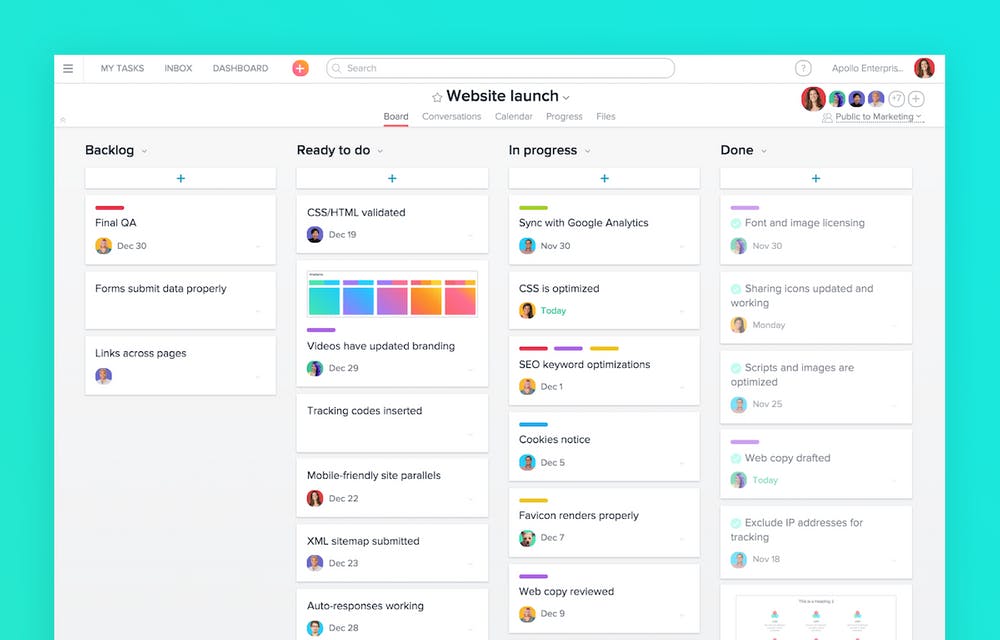
Asana is a quintessential task management application where for every project you create, you can populate it with work items and subitems. You can then add assignees, descriptions, comments, and tags to each work item.
Team collaboration is what makes Asana a sought-after PM solution. Here, you can hold all your squad’s convos in one place so that no info gets lost.
Although Asana caters to both technical and non-technical orgs, it is preferred more by the latter than the former. And so, if you’re a software development org, you’ll find these Asana alternatives impressive.
What makes Asana a good product to manage projects?
- Intuitive user-interface makes work a fun experience
- Flexible and customizable to suit your needs with its custom templates, custom statuses, custom tags, and custom fields
- Supports multiple views such as board, list, calendar, and Gantt to help visualize your projects and a special workload view for resource management
- Loads of integrations with third-party apps available for streamlining your workflows
- Team communication and collaboration capabilities enable holding all your work items and related conversations under one roof Offers unlimited tasks for orgs to get work done even on the free plan
Reasons why some customers dislike Asana's product features
- Too many functionalities that result in a steep learning curve
- Doesn’t support agile capabilities other than a simple kanban board
- Lacks a single nestled view for viewing work items and subitems, unlike Zepel.
- Doesn’t allow assigning multiple users to a single work item
- No
/commands and markdown support to get work done fast - Pricing can get expensive quickly
Top user reviews
- Review on G2: “What do you like best? The interface is really clear and intuitive, it is also beautiful. It is nice to use, you can split the tasks in projects and get updated of what is going on in each product in a simple way, you also have a schedule view where you can see how the project is evolving during time.
People used to like it, very fast learning curve to start using, create tasks and organise everything if you could build a team culture that has the habit of updating and documenting what is going on.
For teams that are not so focused on productivity metrics and agile methodologies (like Marketing, Sales, Customer Success, etc.) could be a great solution.
What do you dislike? If you compare to a more robust tool like JIRA you will miss a lot of productivity and agile metrics like velocity reports, burndown charts and etc. So if you would like to be more predictive about how much work your team can deliver in certain amount of time is not easy to get this information from using Asana. Also if you are working with software development it lacks integration with tools like Github to keep everything synced and easy to find out. If you are using a free version and your company is growing fast be aware that if you reach the limit of the free version the cost for keep using it could be much more than you expected and not fit your budget.”
- Review on Capterra: “As I have primarily only used this for software development tracking, I have found the experience frustrating with lack of good organization and other features. But for any other tasks that are not as specific as software development, it should work great.
Pros: I like the Kanban modes and its integrations with Slack. My company has used this for software development tasks though, and there it lacks in development related features. Fortunately you can get integrations to automatically sync with Jira or other task managers.
Cons: Lacking in complicated workflow creation. It also is not nearly as suited for software development as a task manager such as Jira. Jira allows you to tie a task to a git branch, display commits, keep track of tasks and time tracking better, and has more project manager features.”
P.S. You can find agile metrics, deep integrations with GitHub, GitLab, and Bitbucket, complicated workflow setup, and more in Zepel.
Comparison & difference between Wrike vs Asana - 11 questions to ask
The following 11 questions and answers will help you compare in detail Wrike vs Asana and identify which app is ideal for your squad:
Who’s got a superior UI - Wrike or Asana? Asana’s user-interface is far more intuitive when compared to Wrike, although the latter’s user-interface is simpler. But if you’re looking for a simple but intuitive UI, then check out Zepel.
Which software is easier to get started with? Both the apps are difficult to navigate and get a hang of owing to the wide range of functionalities they offer. But Wrike is easier to get started with than Asana due to the simple design of the app.
Whose functionalities closely match your org’s requirements? Both the platforms are both packed with utilities that enable customizing your workflows. However, Wrike has a comparatively rigid workflow that makes it hard to use.
When it comes to agile, Asana lacks agile capabilities other than a basic kanban board while Wrike offers more functionalities to implement other agile frameworks such as scrum.
Who is more developer-friendly among these two apps? Wrike is a bit more developer-friendly than Asana as it at least supports other agile frameworks such as scrum whereas Asana has only a basic kanban board. But, if developer-friendliness is what you’re after, then you can pick Zepel blindly. Because with Zepel, you get powerful agile capabilities for scrum and kanban and deep integrations with GitHub, GitLab, and Bitbucket. Zepel also supports Markdown and
/commands for getting work done in seconds.Which app helps you collaborate with your squad better? Asana allows you to hold all your team conversations in one place, making collaboration efficient. Whereas Wrike only has a comment box that allows you to @mention members. So when it comes to communication and collaboration, Asana wins hands-down.
Which application to pick in terms of pricing? Wrike as well as Asana offer free plans. The former’s free plan limits functionalities, views, storage, and even the number of users to 5 per organization. The latter’s free plan also limits you to add only 15 members and has restrictions in functionalities. Wrike has a variety of paid plans and accounts start at $9.80 per user per month. On the other hand, Asana’s paid plan starts at $10.99 per member per month billed annually.
But if bucks matter, (of course they do!), you’ll get more value from these free project management software.
Is Wrike’s customer support better or Asana’s? Wrike and Asana’s customer support is below average. You aren’t guaranteed a response period. And so, you’re bound to get equally disappointed by both the apps.
In terms of security, which app is your best bet? Both the PM solutions are quite secure with file encryptions and TLS for securing files in transit. But Wrike’s security slightly outperforms that of Asana’s with its own servers for storage rather than using AWS.
Who wins when it comes to integrations? Wrike has an extensive library of integrations for a wide range of use cases. Asana too is no less when it comes to this and has an impressive lineup of integrations up its sleeve. But Wrike reserves certain integrations to certain tiers and so for a greater number of integrations, you need to shell out more money. Whereas Asana is pretty reasonable and offers more integrations in its lower tiers while reserving advanced integrations for the higher tiers.
Who are the target customers that these apps are meant for? Asana is best for non-IT departments such as marketing, sales, and the like. Meanwhile, Wrike is apt for agile product development organizations that are small in size.
Are there alternatives to Wrike and Asana that are more suitable for your company? Yes, there certainly are more solid alternatives to these two apps that are better suited for your org.
4 recommended alternatives to Wrike and Asana for your business
1. Zepel
The perfect alternative (and #1 choice) to Wrike and Asana is Zepel. The user-interface is simple with an elegant and uncluttered design. But, it is also very intuitive and easy to navigate. This makes onboarding a hassle-free experience.
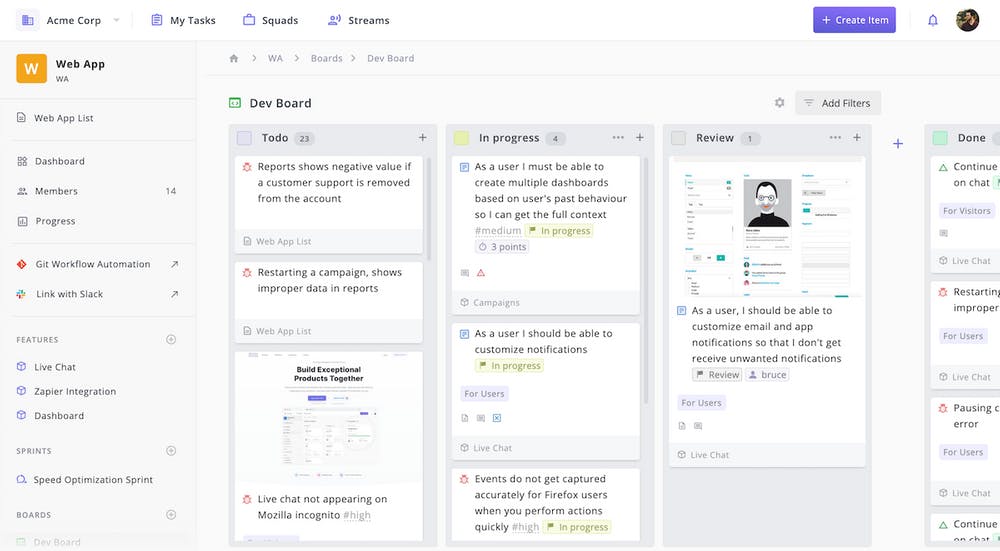
When it comes to functionalities, Zepel has everything your software development squad has only dreamt of - from deep integrations with dev-favourites such as GitHub, GitLab, and Bitbucket to automating your git workflows so that Zepel does the boring grunt work of updating the status of your dev squad’s progress. Zepel also supports / commands and markdown to speed up your work.
With Zepel, you can implement more than just basic kanban. You can implement scrum and even a combination of both efficiently. And that’s why engineering squads revere Zepel as one of the most developer-friendly engineering project management software today. Zepel removes all the chaos from the development process and makes building software products hassle-free.
Zepel completes your development process with a functionality called Streams that brings in customer feedback in the form of requests from various external sources such as Canny, Intercom, etc. Now, you can prioritize and build customer-focussed features for your product with more than mere issue-tracking.
Pricing:
Zepel’s pricing plan comes with a free plan that doesn’t charge you anything for the first 5 members forever no matter how many members you add. When you add your 6th member, the standard annual plan starts at $5/member/month and its standard monthly plan starts at $7/member.
Best For:
Cross-functional teams of any size that desire to build software products with context the agile way.
2. Monday.com
Monday.com is a noteworthy competitor to both the apps as it is loaded with a ton of functionalities and multiple views, namely, calendar, gantt, forms, and so on. This app has plenty of templates for any department, can be customized, and can be automated for certain tasks. This makes building custom workflows easier on monday.com.

Akin to Wrike and Asana, monday.com also supports a lot of integrations with 3rd-party apps such as Slack, OneDrive, Google Calendar, and even with other PM apps like Jira.
But when it comes to agile, it lacks capabilities other than simple kanban. Another minus point is, due to too many functionalities, it is easy to get overwhelmed and the learning curve is steep.
You might be interested in comparing Asana vs Trello vs Monday. Or just Asana vs Monday.
Pricing:
Monday.com’s pricing plan is heavy on the pocket. There isn’t a free plan but instead, a 14-day trial post which you must choose a paid plan, starting at $10/member/month.
Best For:
Non-IT agency and departments pertaining to marketing, sales, etc.
3. ClickUp
ClickUp is also a notable alternative to the two apps. It may appear strikingly similar to Asana but has its differences when you look closer. Here’s a comparison of Asana vs ClickUp elaborating their differences.
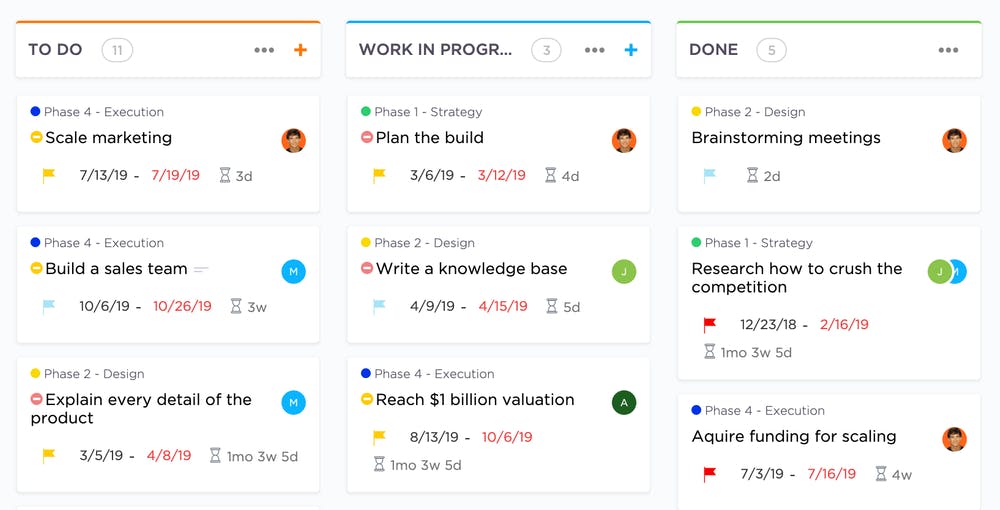
ClickUp aims to be an all-in-one PM platform that replaces all the tools in the market via feature add-ons. From handling tasks to resource management, you’re most likely to find functionality or an add-on for everything here.
But the drawback of this app is that, similar to its peers, it also lacks the powerful agile capabilities that you’ll find in Zepel.
Pricing:
ClickUp’s pricing plan is affordable just like Zepel’s. However, it comes with functionality restrictions that you won’t find even in Zepel’s free plan. ClickUp’s free plan enables you to add unlimited users. However, if you want to access all its functionalities and add-ons, you must purchase a paid plan that starts at $5/user/month.
Best For:
Any business belonging to any industry but ideally non-IT companies.
4. Jira
Jira is one of the pioneers in the PM sector that was initially built as an issue tracking application. But today, it has grown into a PM app that caters to agile development orgs.
With Jira software, you can effortlessly customize your workflows to capture issues and bugs, assign them to members, prioritize and track them to completion.
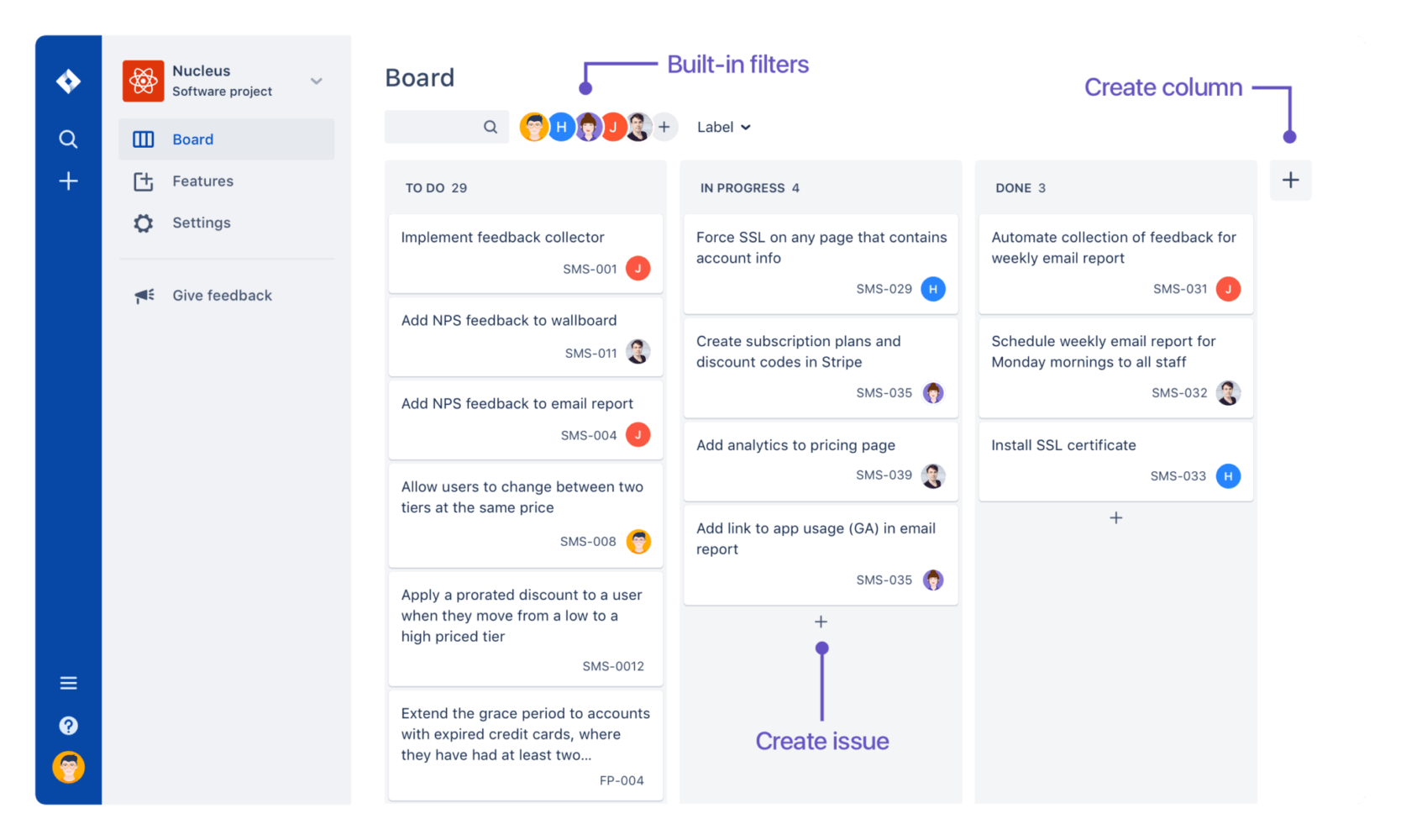
Even though Jira has become a PM platform, it still remains an issue tracker at heart. And that’s why orgs look for Jira alternatives.
Pricing:
Jira software's pricing plan is considerably straightforward. Jira software allows you to add up to 10 members in its free plan but with limited functionalities. The paid plans start at $7/user.
Best For:
Small IT organizations that are looking to build products using agile methodologies.
Find out the comparative advantage of Jira vs Asana here.
5 reasons why Zepel is the ideal project management software
Here are 5 reasons to help you see why Zepel is the perfect platform for your org:
Zepel supports collaboration with squads of any size and because of its intuitive UI and elegant design, without any clutter, onboarding is painless.
You will get the powerful agile capabilities that you've been looking for and you can implement Scrum, Kanban, or both effortlessly.

- Being one of the most developer-friendly PM apps out there having deep integrations with developer-favourite apps and workflow automation, your dev team will love Zepel.

- Handing over priorities from product to development team is hard and creates a disconnect. With Streams in Zepel, you can easily bring customer requests and bug reports from your product stack to handoff to developers. And build customer-focussed software painlessly.

- Zepel offers value-for-money pricing that doesn’t burn a hole in your pocket while providing you with maximum benefits.
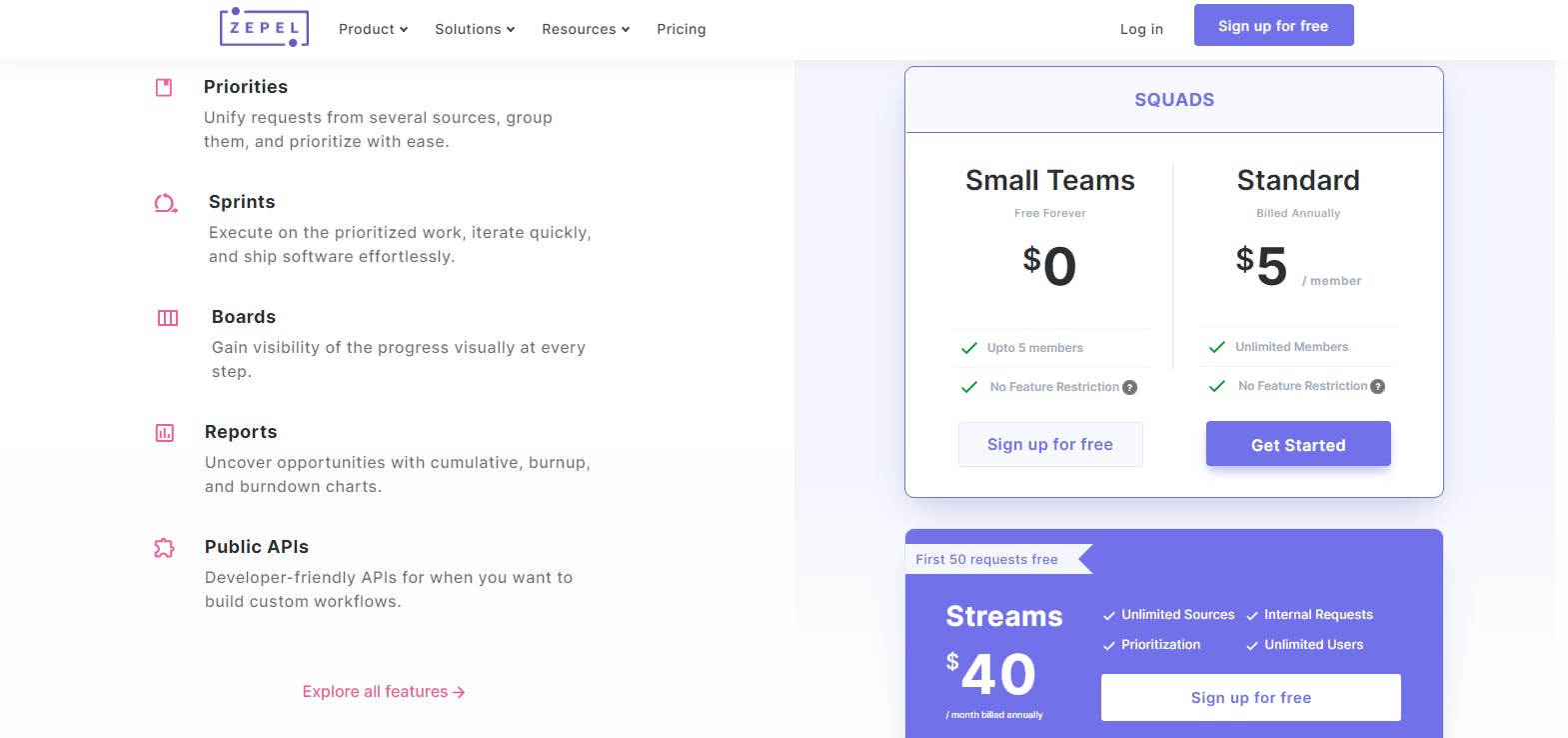
Like what you see? You’ll love Zepel. But don’t take my word for it. See what 4000+ development teams like yours have to say about Zepel.
Sign up and try Zepel for free. Or if you have questions, let’s get on a no strings attached demo call. :)
